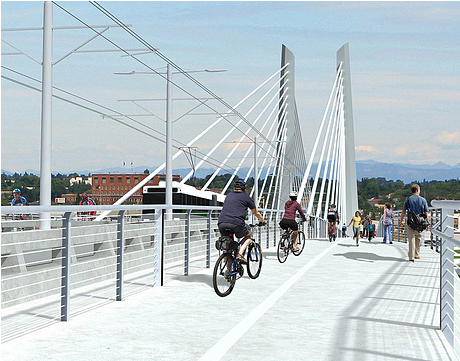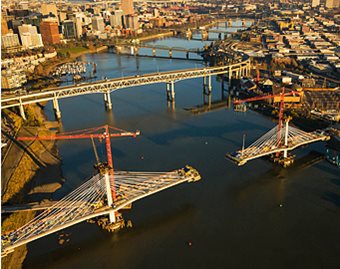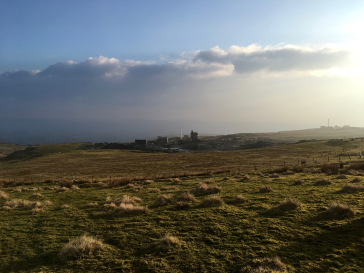Long before it was Portlandia, Oregon’s largest city was known as Bridgetown, a nod to the dozen public bridges that span the Willamette River in Portland’s downtown core. Portland motorists drive with pride over notable bridges such as the nation’s oldest operating vertical-lift drawbridge and the world’s second-longest tied-arch span. But drivers will have to admire Bridgetown’s newest downtown bridge from afar, unless they’re driving a city bus, light rail train, or bike.
 A concept drawing of the bike and pedestrian path on Tilikum bridge. Image: TriMet
A concept drawing of the bike and pedestrian path on Tilikum bridge. Image: TriMet
It’s called “Tilikum Crossing, the Bridge of the People,” but it’s not the bridge of people in cars. When it opens next year, Tilikum Crossing will stand as the only U.S. transit bridge open to virtually every form of commuting except personal motor vehicles.
No Cars AllowedMost comparably sized cities seeking to ease rush-hour gridlock wouldn’t dream of excluding cars from the equation. But it makes sense here, where alternative transporation is part of the community ethos. For all of Portland’s quirks, urban planners everywhere admire it as a city that works. These two traits come together in this $134.6-million project, the first new bridge over the Willamette in 40 years. It’s just one component of the $1.49-billion expansion of Portland’s vaunted public transportation system along a 7.3-mile corridor to the southeastern suburb of Milwaukie
On a typical weekday, nearly 19,000 bike commuters pedal over the five existing bike-friendly bridges – about 212% more than a decade ago. TriMet, the regional transit agency, estimates 45% of downtown workers commute by bus or rail every day. TriMet spokeswoman, Mary Fetsch, says the new light rail project should trigger a 20% jump in transit use in the new service corridor and a reduction of about 9,100 trips per week by private vehicles. The project also will help revitalize neighborhoods along the route.
Tilikum’s TechnologyAccording to the design-build team at Kiewitt Infrastructure West, the structure combines two different technical bridge types in one design: concrete segmental technology and a relatively new cable-stay technology.
 The construction of the Tilikum Crossing. Image
The construction of the Tilikum Crossing. Image
Cost, aesthetics, and environmental factors inspired the choice of an open-grid cast-in-place segmental cable-stayed design, Kiewitt states. Each of the 76 bridge segments is 16-feet long and weighs 440,000 pounds, yet was designed to be as thin as possible to maximize the vertical clearance for marine traffic below. To support the span during construction, crews placed temporary cable stays beneath each permanent stay.
The bridge’s iconic profile evokes two enormous ship sails, an effect created by the system of steel support cables radiating down from two imposing concrete towers. About 3.5 miles of cabling runs through the tower structures, which soar 180 vertical feet from pier cap to top.
The typical width of the span is 75.5 feet, bulging out to 110 feet at the towers to create viewpoints. A 14-foot bike/pedestrian lane on either side provides extra width to accommodate the mixed pace of traffic expected to include wheelchair users, runners, power walkers, and sightseers. Central lanes will carry tracks both for light rail trains and for the future use of the city’s expanding streetcar line. Three bus routes will share the roadway with the trains and the occasional emergency vehicle, but that is the only nod to internal combustion on Tilikum Crossing.
Fittingly for a bridge conceived in the spirit of sustainability, the construction process was designed around the migratory patterns of the river’s salmon population. Work involving the river bottom was completed during the July-October “fish window” set by the National Marine Fisheries Service, when migration is at its lowest. The use of cable-stayed support eliminates the need for intermediate towers in the river, which further reduces disturbance to the habitat.
Michael MacRae is an independent writer.
Share this:




